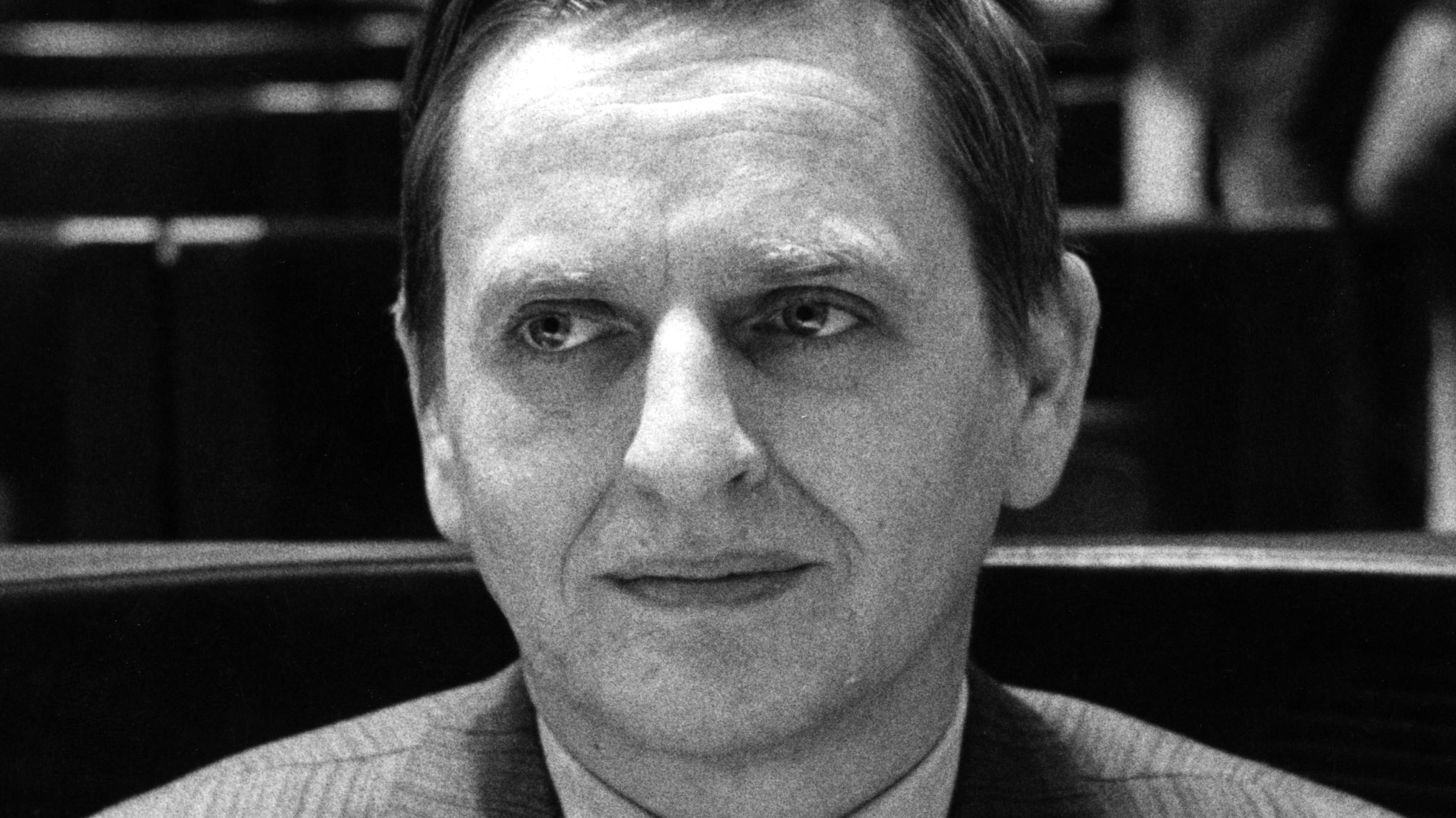Behind the mysterious 80s assassination of Sweden’s prime minister
Prosecutors claim they have caught the killer in 34-year-old cold case

Swedish prosecutors have named the man who they say killed former Swedish prime minister Olof Palme in 1986, ending more than 30 years of mystery and intrigue.
Palme was gunned down while walking home from the cinema with his wife, while serving his second term as Swedish PM.
The murderer was never caught, prompting fascination in a nation with low murder rates and even lower incidences of political violence.
The Week
Escape your echo chamber. Get the facts behind the news, plus analysis from multiple perspectives.

Sign up for The Week's Free Newsletters
From our morning news briefing to a weekly Good News Newsletter, get the best of The Week delivered directly to your inbox.
From our morning news briefing to a weekly Good News Newsletter, get the best of The Week delivered directly to your inbox.
Who was Olof Palme?
Palme led the centre-left Swedish Social Democratic Party from 1969 until his death in the mid-80s.
In many ways he embodied the characteristics of many left-wing politicians, voicing opposition to US and Soviet foreign policy, attacking the Franco dictatorship in Spain and condemning the war in Vietnam. Palme was very popular among the left, but disliked by many liberals and conservatives.
He also “made a point of living as much as possible like an ordinary person”, The Guardian says, and “did not want the fact that he was running the country to come between him and his countrymen”.
A free daily email with the biggest news stories of the day – and the best features from TheWeek.com
Swedish ethnologist Jonas Engman told the paper that Swedes “saw him in the streets all the time... You could speak to him. There was an intimacy to it”.
Ultimately though, his tendency to take to Sweden’s streets would be his undoing.
Who would murder the PM?
This is the question that has confounded investigators since his murder.
On the night of 28 February 1986, Palme, who NPR says had dismissed his security detail earlier in the day, was fatally shot in the back at point-blank range.
The murder took place “on one of the busiest streets in downtown Stockholm”, the broadcaster adds, while Palme was walking with his wife, Lisbet Palme.
Lisbet, who was injured but survived the attack, later identified Christer Pettersson as the killer, with Palme’s then-24-year-old son, Marten, also identifying Pettersson.
Pettersson “often hung around” the area, The Guardian reports, and “had spent time in prison for randomly stabbing someone to death with a bayonet”.
In July 1989, he was convicted and sentenced to life in prison. “For a moment,” the paper says, “it seemed that this national trauma was over”.
However, Pettersson appealed the conviction and “his sentence was overturned the following year after the police found no technical evidence against him”, Sky News says.
Since Petterson’s acquittal, “more than 100 people have been suspected of the attack”, the broadcaster adds, setting up a 30-year hunt for the truth in “the killing of the most controversial leader in Sweden’s modern history”, as The Guardian puts it.
What has happened now?
Swedish prosecutors have announced that the case is closed - they believe that they have caught their man.
The gunman has been named by prosecutors as Stig Engstrom, “a conservative-minded graphic designer popularly known as the ‘Skandia man’”, The Times says.
Engstrom, investigators say, “supposedly used a long-barrelled revolver to shoot the prime minister... before fleeing down a side road and taking the night bus home,” the paper adds.
Engstrom gained the nickname “Skandia man”, as in his initial dealings with police he said that he had “pursued the killer”, before returning to the office of insurance company Skandia, where he was employed.
Police dismissed Engstrom during their original investigation, but in 2016, Lars Larsson, a writer, accused Engstrom of the murder in a book called Nationens Fiende, or Enemy of the State.
In 2018, journalist Thomas Pettersson [no relation to Christer Pettersson] wrote a series of articles in Swedish magazine Filter arguing that Palme’s son, who originally identified Pettersson, saw a man who resembled Engstrom near the scene of the crime.
In a 2018 interview with The New York Times, Thomas Petterson claimed Engstrom had “the right timing, the right clothing... unique information” and had “a deep political interest and a deep anti-Palme sentiment”.
–––––––––––––––––––––––––––––––For a round-up of the most important stories from around the world - and a concise, refreshing and balanced take on the week’s news agenda - try The Week magazine. Start your trial subscription today –––––––––––––––––––––––––––––––
A mystery solved?
Not quite. Chief Prosecutor Krister Petersson [no relation to Christer or Thomas] has said that they are now closing the case, but Engstrom cannot be indicted as he is dead.
Engstrom died, by apparent suicide, in 2000, NPR says, meaning that the question of who killed Palme will likely remain a mystery in the eyes of many Swedes.
Krister Petersson said that the way Engstrom “acted was how we believe the murderer would have acted”, but conceded that investigators still do not have a “clear picture” of Engstrom’s motive,
Palme’s three sons welcomed the police verdict as a “compelling” account of their father’s death. Marten Palme, now 58, said: “I think the suspicions regarding this suspect are credible... But you can’t say with 100% certainty that he was the person who carried out the killing.”
A chief witnesses in the case, Leif Ljungqvist, is less convinced, labeling the official account a “scandal” and saying that it was “impossible” that Engstrom could have carried out the murder.
The case has developed into a “favorite topic of conspiracy theorists”, NPR says, “who have variously posited the involvement of the CIA, Kurdish separatists, the South African security services and Chilean fascists, among others”.
Despite police saying they have indentified the killer, the reaction suggests public curiosity over the case is unlikely to diminish.
-
 5 criminally underrated cartoons about Pete Hegseth’s war crime
5 criminally underrated cartoons about Pete Hegseth’s war crimeCartoon Artists take on USS Hegseth, rats leaving the sinking ship, and more
-
 Can Mike Johnson keep his job?
Can Mike Johnson keep his job?Today's Big Question GOP women come after the House leader
-
 A postapocalyptic trip to Sin City, a peek inside Taylor Swift’s “Eras” tour, and an explicit hockey romance in December TV
A postapocalyptic trip to Sin City, a peek inside Taylor Swift’s “Eras” tour, and an explicit hockey romance in December TVthe week recommends This month’s new television releases include ‘Fallout,’ ‘Taylor Swift: The End Of An Era’ and ‘Heated Rivalry’
-
 Femicide: Italy’s newest crime
Femicide: Italy’s newest crimeThe Explainer Landmark law to criminalise murder of a woman as an ‘act of hatred’ or ‘subjugation’ but critics say Italy is still deeply patriarchal
-
 Brazil’s Bolsonaro behind bars after appeals run out
Brazil’s Bolsonaro behind bars after appeals run outSpeed Read He will serve 27 years in prison
-
 Americans traveling abroad face renewed criticism in the Trump era
Americans traveling abroad face renewed criticism in the Trump eraThe Explainer Some of Trump’s behavior has Americans being questioned
-
 Nigeria confused by Trump invasion threat
Nigeria confused by Trump invasion threatSpeed Read Trump has claimed the country is persecuting Christians
-
 Sanae Takaichi: Japan’s Iron Lady set to be the country’s first woman prime minister
Sanae Takaichi: Japan’s Iron Lady set to be the country’s first woman prime ministerIn the Spotlight Takaichi is a member of Japan’s conservative, nationalist Liberal Democratic Party
-
 Russia is ‘helping China’ prepare for an invasion of Taiwan
Russia is ‘helping China’ prepare for an invasion of TaiwanIn the Spotlight Russia is reportedly allowing China access to military training
-
 Interpol arrests hundreds in Africa-wide sextortion crackdown
Interpol arrests hundreds in Africa-wide sextortion crackdownIN THE SPOTLIGHT A series of stings disrupts major cybercrime operations as law enforcement estimates millions in losses from schemes designed to prey on lonely users
-
 China is silently expanding its influence in American cities
China is silently expanding its influence in American citiesUnder the Radar New York City and San Francisco, among others, have reportedly been targeted